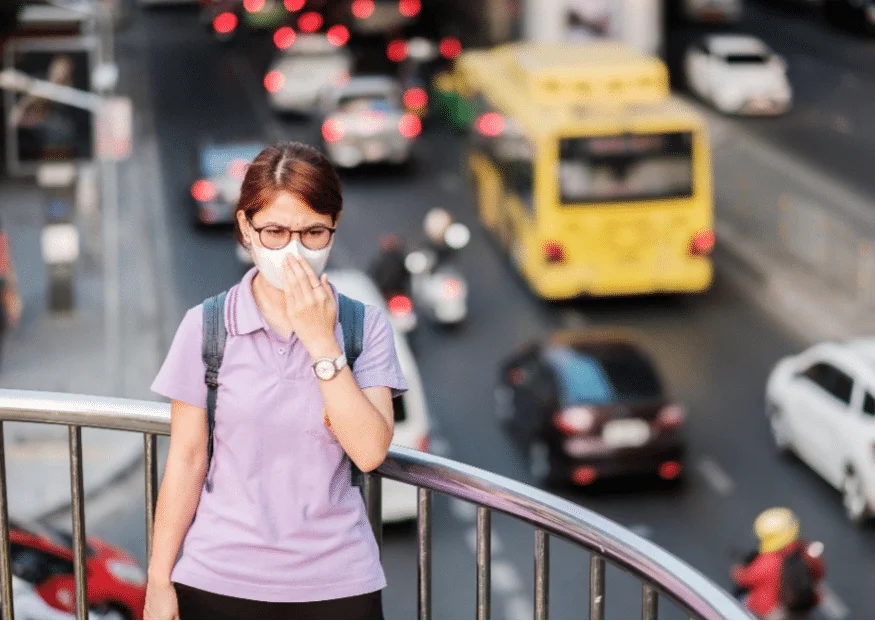
As is well known, smog is a major enemy of human health. The finer the dust is, the longer it will float in the air and the easier it will be inhaled by the human body. Especially respirable dust smaller than 5 micrometers, these dusts will directly enter the alveoli and be deposited. When they reach a certain amount, they will cause silicosis or other pneumoconiosis diseases, resulting in loss of working ability at the least and death at the worst. With the vigorous development of industrialization, more and more air pollution problems have emerged, and anti-haze masks have also come into being.
Which type of haze mask is good?
1.Activated carbon masks: This type of mask is the most widely used in daily life. It is a filtering mask, mainly consisting of the mask frame and the filter material contained inside. Generally, dust-proof filter cotton and anti-toxic chemical filter boxes are used, etc. The effect of preventing haze is not good.
2. Flat masks: Flat masks are mostly made of soft PP material, mainly highlighting the design of the nose bridge clip. They can be adjusted specifically according to different face shapes and are very comfortable styles. It can effectively filter out some visible or invisible substances that are harmful to the human body, and its anti-haze effect is average.
3. N95 masks: N95 masks are professional protective masks that can effectively block PM2.5, which is a very good choice for preventing haze. Their blocking rate for 0.3-micron particles is over 95%, but they only provide temporary protection. The masks are relatively airtight, making breathing difficult. Wearing them for a long time may cause symptoms of oxygen deficiency.
What are the current mainstream standards for anti-haze masks?
National standard: KN90 (filtration efficiency of 90%), KN95 (filtration efficiency of 95%), KN100 (filtration efficiency of 99.97%) American standard: N90 (filtration efficiency of 90%), N95 (filtration efficiency of 95%) European standard: The filtration efficiency of FFP1 (filtration efficiency ≥80%), FFP2 (filtration efficiency ≥94%), and FFP3 (filtration efficiency ≥99%) in China and the United States only applies to non-oily particles, while the European standard covers both oily and non-oily particles. For daily protection, you can choose the national standard or the American standard. KN95 level is sufficient. Although KN100 has a good filtration efficiency, it has a large breathing resistance and is not suitable for most people to use. If you work in a factory or an environment with oily particulate matter for a long time, you can purchase masks of the European standard FFP2 level.
How to Choose Anti-Haze Masks?
1.The shape fits the face: The better the mask fits the face, the better the protective effect, because the protective effect of the mask is closely related to the fit between the mask and the face when worn. It has good fit, and the air outside the mask is not easy to enter the mask from the edge and be inhaled by the human body.
2. Appropriate breathing resistance: It's not the case that the tighter the mask, the better. Some masks have too much breathing resistance when worn, which may even cause harm to the respiratory system of the human body. So when choosing a mask, try it on and press it close to your face to feel if you have difficulty breathing.
3. Observe whether it meets the product standards: Currently, the standards related to mask products include GB2626-2006 "Respiratory Protective Equipment - Self-inhalation Filtering Particulate Respirators", GB19083-2010 "Technical Requirements for Medical Protective Masks", and YY0469-2011 "Medical Surgical Masks". When choosing anti-haze masks, you can pay attention to whether the outer packaging has the relevant standard certification of GB2626-2006.
4. Select big brands: Besides the above standards, choosing reliable big brands is also a guarantee of safety.
Which groups of people are not suitable for wearing anti-haze masks?
1.Pregnant woman.
2. Children.
3. Patients with upper respiratory tract infections.
4. People with chronic respiratory diseases or asthma and other lung function impairments.
5. Patients with heart disease.
6. People who experience dizziness, breathing difficulties and sensitive skin after wearing it.
7. Those with obvious facial scars that affect the tight fit of the mask to the face. The better the mask filters out suspended particles, the more strenuous it is to breathe. Wearing it for a long time can easily lead to hypoxia, chest tightness and other conditions. Pregnant women, infants and young children, and the elderly with weak constitutions should try their best to avoid wearing anti-haze masks that have a relatively large barrier to breathing.
What are the common misunderstandings about using anti-haze masks?
1. The mask can still be used after washing: The filter core of the anti-haze mask is made of electrostatic adsorption material, and it becomes ineffective after being washed with water. Wearing it again not only fails to prevent haze but also the damp filter will breed bacteria, further threatening human health.
2. Take off masks as soon as you get on the subway: Many people take off their masks as soon as they get on the subway, which is incorrect. Public places such as subways, buses and shopping malls are crowded with people and have a large flow of people. There must be a large amount of pollutants in the air. The PM2.5 content in subways is many times higher than that outdoors. Therefore, it is recommended that everyone wear anti-haze masks properly on the subway on smoggy days. 3. Long-term wearing: Masks with good airtightness should not be worn for more than two hours. They should be taken off to breathe after about half an hour. In addition, during the process of putting on and taking off the mask, try not to expose the inner layer of the mask, as it will come into contact with dirty air from outside, reducing the service life of the mask.
4. Wearing a mask keeps you healthy: Anti-haze masks can indeed block the harm of pollutants and bacteria to the human body. However, people with severe hypertension, heart, lung or respiratory system diseases or difficulties (such as asthma, emphysema) should not wear masks, as it may be dangerous. ps: If there is dirt and an unpleasant smell in the anti-haze mask and the breathing resistance is too high, it is advisable to replace the mask immediately. At this point, the mask has lost its protective function and the accumulated harmful substances will be even more harmful to human health.
5. Whether a mask has an exhalation valve or not is of little significance: Professional PM2.5 masks are divided into two types, with and without exhalation valves, and are marked with symbols such as N and KN. N95 indicates that its ability to capture particles smaller than 2.5 microns is 95%. The KN90 has a capture capability of 90%. People with poor heart and lung function are advised to choose masks with air valves as much as possible. The wearing time of this type of anti-haze mask is generally about two days. It is reasonable to reuse one mask 3 to 5 times, each time for 1 to 2 hours.
6. Do not remove the mask when coughing or sneezing: Coughing or sneezing


 04-Aug--2025
04-Aug--2025